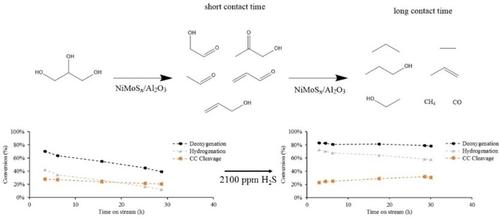当前位置:
X-MOL 学术
›
ChemCatChem
›
论文详情
Our official English website, www.x-mol.net, welcomes your feedback! (Note: you will need to create a separate account there.)
The Hydrodeoxygenation of Glycerol over NiMoSx: Catalyst Stability and Activity at Hydropyrolysis Conditions
ChemCatChem ( IF 4.5 ) Pub Date : 2020-10-21 , DOI: 10.1002/cctc.202001289 Anthony D. Anderson 1 , Michael P. Lanci 2 , J. Scott Buchanan 1 , James A. Dumesic 1 , George W. Huber 1
ChemCatChem ( IF 4.5 ) Pub Date : 2020-10-21 , DOI: 10.1002/cctc.202001289 Anthony D. Anderson 1 , Michael P. Lanci 2 , J. Scott Buchanan 1 , James A. Dumesic 1 , George W. Huber 1
Affiliation

|
Catalytic activity tests were run to elucidate the chemistry and catalyst stability for the hydrodeoxygenation of glycerol and other aliphatic oxygenates over a NiMoSx/Al2O3 catalyst at different pretreatments at hydropyrolysis conditions in a continuous flow reactor. Reactivity metrics were developed to quantify and compare the reactivity of NiMo for deoxygenation, hydrogenation, and C−C cleavage. Activity experiments showed sulfided NiMo and reduced NiMo catalysts had similar deoxygenation and hydrogenation activity for glycerol HDO at 400 °C and 270 psig H2 with the NiMoSx catalyst showing higher C−C cleavage activity. Without a sulfur co‐feed, both the NiMoSx and NiMoOx catalysts lost >40 % deoxygenation activity over 30 h time on stream. With a 2100 ppm H2S co‐feed the NiMoSx catalyst showed a 12 times decrease in the deactivation rate for deoxygenation and 6 time decrease in the deactivation rate for hydrogenation. The main products at high conversion were propylene, propane, ethylene, methane, CO, methanol, ethanol, and 1‐propanol. At low conversion, the major products were unsaturated allyl alcohol, acrolein, hydroxyacetone, and acetaldehyde. With no H2S co‐feed at short contact times, there was a significant amount of carbon loss possibly due to condensation reactions, while at 2100 ppm H2S in the feed, the carbon balance was 102.4 %. Temperature programmed oxidation of the spent NiMoSx catalysts after 30 h of glycerol HDO without an H2S co‐feed showed that one of the causes of deactivation was coking.
中文翻译:

NiMoSx上甘油的加氢脱氧:加氢热解条件下催化剂的稳定性和活性
进行了催化活性测试,以阐明在连续流动反应器中的加氢热解条件下,在不同的预处理条件下,采用NiMoS x / Al 2 O 3催化剂对甘油和其他脂肪族含氧化合物进行加氢脱氧的化学性质和催化剂稳定性。开发了反应性指标以量化和比较NiMo对脱氧,氢化和C-C裂解的反应性。活性实验表明,硫化的NiMo和还原的NiMo催化剂在400°C和270 psig H 2下对甘油HDO具有相似的脱氧和氢化活性,而NiMoS x催化剂显示出更高的C-C裂解活性。没有硫共进料,NiMoS x和NiMoOx催化剂在运行30小时内失去了> 40%的脱氧活性。使用2100 ppm H 2 S共进料时,NiMoS x催化剂的脱氧失活速率降低了12倍,而加氢失活速率降低了6倍。高转化率的主要产品是丙烯,丙烷,乙烯,甲烷,CO,甲醇,乙醇和1-丙醇。在低转化率下,主要产物是不饱和烯丙醇,丙烯醛,羟丙酮和乙醛。在短时间内没有H 2 S共进料的情况下,可能由于缩合反应导致大量的碳损失,而在2100 ppm H 2下进料中的S,碳平衡为102.4%。在没有H 2 S共同进料的甘油HDO 30小时后,对NiMoS x废催化剂进行程序升温氧化表明,失活的原因之一是焦化。
更新日期:2020-10-21
中文翻译:

NiMoSx上甘油的加氢脱氧:加氢热解条件下催化剂的稳定性和活性
进行了催化活性测试,以阐明在连续流动反应器中的加氢热解条件下,在不同的预处理条件下,采用NiMoS x / Al 2 O 3催化剂对甘油和其他脂肪族含氧化合物进行加氢脱氧的化学性质和催化剂稳定性。开发了反应性指标以量化和比较NiMo对脱氧,氢化和C-C裂解的反应性。活性实验表明,硫化的NiMo和还原的NiMo催化剂在400°C和270 psig H 2下对甘油HDO具有相似的脱氧和氢化活性,而NiMoS x催化剂显示出更高的C-C裂解活性。没有硫共进料,NiMoS x和NiMoOx催化剂在运行30小时内失去了> 40%的脱氧活性。使用2100 ppm H 2 S共进料时,NiMoS x催化剂的脱氧失活速率降低了12倍,而加氢失活速率降低了6倍。高转化率的主要产品是丙烯,丙烷,乙烯,甲烷,CO,甲醇,乙醇和1-丙醇。在低转化率下,主要产物是不饱和烯丙醇,丙烯醛,羟丙酮和乙醛。在短时间内没有H 2 S共进料的情况下,可能由于缩合反应导致大量的碳损失,而在2100 ppm H 2下进料中的S,碳平衡为102.4%。在没有H 2 S共同进料的甘油HDO 30小时后,对NiMoS x废催化剂进行程序升温氧化表明,失活的原因之一是焦化。



























 京公网安备 11010802027423号
京公网安备 11010802027423号